Petrochemical
Biodegradable Plastic Bag Processing Project of Baicheng City
1. Introduction to the Project
1.1 Project background
1.1.1 Product introduction
Biodegradable plastic bags are environmentally friendly plastic products, mainly made of biodegradable polymer materials. These polymer materials can be decomposed by microorganisms and ultimately converted into harmless substances such as carbon dioxide and water, thus avoiding the long-term pollution of the environment caused by traditional plastic bags.
The introduction of the “plastic restriction order” and the expansion of the green consumption market have made biodegradable plastic products one of the most promising biomaterials for the new generation, which will occupy more market share. The biodegradable plastic industry will usher in new opportunities for development. Tongyu County is rich in sunflowers, castor beans, mung beans, melon seeds, corn, sorghum, millet, miscellaneous grains and beans, sesame seeds, vegetables, cotton, chili peppers, sweet corn, and crop straw. The development of biodegradable plastic bags has a very broad development space.
1.1.2 Market prospect
(1) Current situation of biodegradable plastic market
The upstream of the biodegradable plastics industry chain consists mainly of raw materials such as starch, plant straw, chitin, functional additives, petroleum, natural gas, and coal, as well as plastic machinery such as plastic pellet equipment, granulation equipment, and blown film machines. The midstream of the industrial chain is the production and processing of biodegradable plastic products, mainly including biobased biodegradable plastics and fossil based biodegradable plastics. Biodegradable plastics are mainly used in downstream industries such as retail, packaging, and agriculture.
With the increasing global environmental protection efforts, “plastic restrictions” have been implemented in more than 60 countries. According to data from Huirui Consulting, the global biodegradable materials market was expected to reach about US$ 5.732 billion in 2023 and is projected to reach about US$ 27.703 billion by 2030, with an average annual compound growth rate of 21.73%. This is mainly due to the increasing global environmental awareness, restrictions on disposable plastic products in various countries, and the growing demand for sustainable materials in various industries. The rapid growth in demand for biodegradable materials in various fields such as packaging, agriculture, and healthcare has driven the sustained expansion of the market. Meanwhile, technological advancements are constantly reducing production costs, enabling more companies to adopt these materials, thereby accelerating the increase in market penetration.
China has been implementing plastic restrictions since 2008, with increasingly strict regulatory measures. In 2020, the National Development and Reform Commission and the Ministry of Ecology and Environment proposed action goals and measures to restrict and prohibit the use of non-degradable plastic products in stages (2020, 2022, 2025) in the Opinions on Further Strengthening the Control of Plastic Pollution. Across the country, especially in areas with severe plastic pollution, the government has implemented a series of policies and action plans to encourage businesses to use biodegradable materials to replace traditional plastics. Specific measures include the implementation of plastic ban and restriction policies, as well as strict environmental requirements for packaging, agricultural films, and disposable consumer goods. The comprehensive implementation of the “plastic ban” in Jilin Province in 2015 has led to a steady increase in demand for biodegradable plastics throughout the province.
China’s biodegradable plastic industry started relatively late, but has developed rapidly under the dual factors of policy support and market demand. Currently, China has become the world’s largest producer of biodegradable plastics. In 2018, China produced 180,000 tons of biodegradable plastics, with a total output of 795,400 tons in 2022 and 1 million tons in 2023. The compound annual growth rate was about 44.19% during 2018-2023.
Figure 1Production and Growth Rate of Biodegradable Plastics in China during 2018-2023
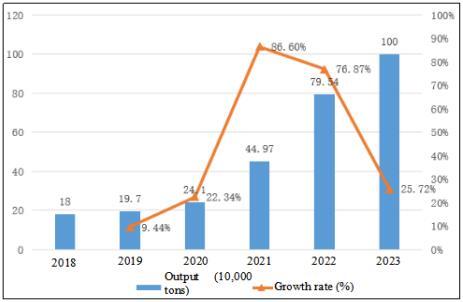
Due to the continuous expansion of the application scope of biodegradable plastics, downstream disposable biodegradable plastic products such as disposable biodegradable shopping bags and biodegradable disposable tableware are steadily developing. In 2018, the consumption of biodegradable plastics in China was 164,100 tons, which increased to 653,400 tons in 2022 and 900,000 tons in 2023. The compound annual growth rate was 42.98% during 2018-2023.
Figure 2Consumption and Growth Rate of Biodegradable Plastics in China during 2018-2023
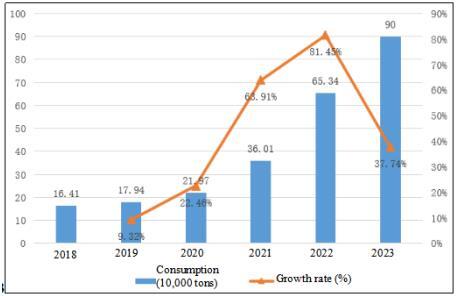
With the increasing awareness of environmental protection among consumers, the demand for biodegradable materials in packaging, catering, agriculture, and daily consumer goods is gradually increasing. The food delivery and logistics packaging industries have begun to introduce biodegradable packaging to reduce the burden of plastic waste on the environment. The market size of biodegradable plastics in China was 4.056 billion yuan in 2018, and increased to 9.1 billion yuan in 2021. By 2022, it had increased to 16.049 billion yuan. In 2023, the market size of biodegradable materials in China reached 17.312 billion yuan, a year-on-year increase of 7.87%.
Figure 3Market Size and Growth Rate of Biodegradable Plastics in China during 2018-2023
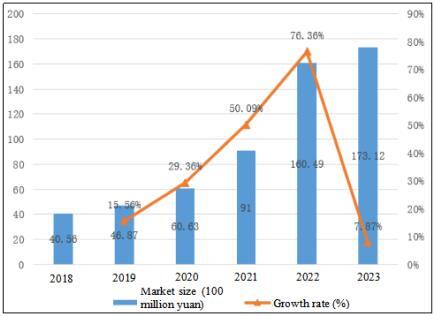
Biodegradable plastic products mainly include express packaging, disposable tableware, disposable biodegradable shopping bags, and other products (such as agricultural film). The market for disposable biodegradable shopping bags and disposable tableware is relatively large, while the market for express packaging is relatively small. In 2022, the market size of disposable biodegradable shopping bags was 11.475 billion yuan, the market size of disposable tableware was 3.467 billion yuan, the market size of express packaging was 754 million yuan, and the market size of other markets was 353 million yuan. The market size of disposable biodegradable shopping bags accounts for 71.50% of the market size of biodegradable plastic products.
Figure 4Market Size of China’s Biodegradable Plastic Industry Segments in 2022 (Unit: 100 million RMB)

(2) Project Market Forecast
In recent years, China has made significant progress in biodegradable plastic technology, with the technological level of biodegradable materials such as PLA (polylactic acid), PBAT (poly (hexanedioic acid)/butylene terephthalate), PHA (polyhydroxyalkanoate) continuously improving and production costs gradually decreasing, providing technical support for the widespread application of biodegradable plastic bags. Furthermore, some companies have also developed biodegradable plastic bag products with higher performance and lower cost through technological innovation, further promoting the development of the industry.
Its application fields are constantly expanding with the continuous advancement of biodegradable plastic bag technology and the gradual reduction of costs. In addition to traditional packaging, shopping bags, and other fields, the application of biodegradable plastic bags in agriculture, healthcare, construction, and other fields is gradually increasing. For example, biodegradable plastic bags are used as mulching films in the field of agriculture, which can not only maintain soil temperature and humidity, increase crop yields, but also reduce agricultural film pollution and achieve sustainable agricultural development.
With the continuous advancement of technology and the continuous maturity of the market, biodegradable plastic bags will become one of the important means to reduce plastic pollution and achieve green development. At present, the biodegradable plastic bag industry is in a rapid development stage. With the increasing awareness of environmental protection, biodegradable plastic bags, as an important alternative to reduce plastic pollution, continue to grow in market demand.
This project uses the abundant crop resources in Tongyu County to develop biodegradable plastic products, which have a very broad market development prospect.
1.1.3 Technical analysis
The project adopts modern production technology and automated production lines, with mature production processes and technologies, and has the conditions for large-scale production.
The project adopts the production process of blown film bag making.
The project adopts the production process of blown film bag making, and * is the key control point.

1.1.4 Advantageous conditions of project construction
(1) Policy advantages
In May 2022, the National Development and Reform Commission released the 14th Five-Year Plan for the Development of Bioeconomy, which proposed to promote the application of biodegradable material products, focusing on demonstration applications in daily products, agricultural film, packaging materials, textile materials and other fields, promoting the reduction of production costs and the improvement of product performance, and actively exploring the market for biomaterials products.
In September 2021, the National Development and Reform Commission and the Ministry of Ecology and Environment issued a Notice on the Issuance of the Action Plan for Plastic Pollution Control during the 14th Five-Year Plan Period, fully considering the full life cycle resource and environmental impacts of bamboo and wood products, paper products, biodegradable plastic products, etc., and improving the quality and food safety standards of related products. Intensify the R&D of key core technologies for biodegradable plastics, continuously improve product quality and performance, and reduce application costs.
In the Outline of the 14th Five-Year Plan for National Economic and Social Development and Vision 2035 of the People’s Republic of China, it is proposed to promote the integration and innovation of biotechnology and information technology, accelerate the development of industries such as biomedicine, biological breeding, biomaterials, and bioenergy, and expand and strengthen the bioeconomy.
In May 2022, the National Development and Reform Commission released the 14th Five-Year Plan for the Development of Bioeconomy, proposing to promote the application of biodegradable material products, with a focus on demonstration applications in daily products, agricultural film, packaging materials, textile materials and other fields, to promote the reduction of production costs and the improvement of product performance, and actively explore the market for biomaterials products.
In November 2022, five departments including the Ministry of Science and Technology and the Ministry of Ecology and Environment issued the 14th Five-Year Plan for Scientific and Technological Innovation in the Ecological Environment Field, proposing to study the full life cycle ecological design and evaluation methods for key products such as plastic packaging and automobiles, break through key technologies such as efficient preparation of degradable plastics, develop analysis and detection technology for degradable plastic degradation products, and develop carbon label evaluation benchmark methods for solid waste resource utilization products and native products.
The Regulations on Prohibiting the Production, Sale, and Provision of Disposable Non-Degradable Plastic Shopping Bags and Plastic Tableware in Jilin Province came into effect on January 1, 2015. The production and sale of non-degradable plastic shopping bags and plastic tableware are prohibited within the administrative area of this province.
(2) Resource advantages
The total cultivated land area of Tongyu County is 6.619 million mu, the total grassland area is 1.6945 million mu, and the total wetland area is 485,600 mu. The unused land area is 145,600 hectares. Adequate industrial and construction land.
Tongyu County has abundant power reserves. Tongyu is one of the regions with the richest wind energy reserves in the province, with a wind power density of 308 watts per square meter and an annual effective power generation time of over 3,900 hours. The county has a developed wind farm area of 1,643 km2 and a capacity of over 18 million KW. In terms of solar energy, the average annual sunshine duration in the county exceeds 2,900 hours, with solar radiation reaching over 5,200 megajoules per square meter and a sunshine percentage of over 65%. The annual effective photovoltaic power generation hours can reach 1,700 hours, making it the region with the richest sunshine resources in Jilin Province.
(3) Industrial advantages
Tongyu County is rich in sunflowers, castor beans, mung beans, melon seeds, corn, sorghum, millet, miscellaneous grains and beans, sesame seeds, vegetables, cotton, chili peppers, sweet corn, and crop straw. The highest annual output of sunflowers is 120,000 tons, making it one of the four major production areas in China. The highest annual output of castor bean is 60,000 tons, accounting for about one sixth of the country’s total. The maximum annual production of mung beans and melon seeds is 80,000 tons and 50,000 tons respectively. The highest annual output of corn is 1.746 million tons, the highest annual output of sorghum is 150,000 tons, the highest annual output of foxtail millet is 55,200 tons, the highest annual output of miscellaneous grains and beans is 10,000 tons, the highest annual output of sesame is 10,000 tons, the highest annual output of vegetables is 50,000 tons, the highest annual output of cotton is 15,000 tons, the highest annual output of chili pepper is 50,000 tons, and the highest annual output of sweet corn is 20,000 tons. Tongyu County has a reliable source of biodegradable plastic raw materials for development.
(4) Location and transportation advantages
Tongyu County has a superior transportation location. In terms of highways, 100% of towns and villages in the county have access to graded highways, and all administrative villages and natural settlements with more than 20 households have access to hardened roads. National highways G334, G231, and G503 intersect and pass through the county town. The intersection of Tieli - Keshan Expressway and Nenjiang- Shuangliao Expressway in Tongyu has effectively driven the rapid development of Tongyu. In terms of railways, the railway transportation network is constantly improving, and the Pingqi Railway runs north-south. The Qiqihaer - Tongliao High-speed Railway and Tongyu General Airport have been included in the 14th Five-Year Plan. Tongyu County will gradually build a convenient and efficient transportation network with railways, highways, high-speed trains, and expressways running parallel in all directions.
(5) Talent advantages
There are Academy of Agricultural Sciences, Academy of Forestry Sciences, Agricultural Machinery Research Institute, Animal Husbandry Research Institute, Scientific Research Institute and other scientific research institutes in Baicheng City. There are 40,873 professional and technical personnel, including 6,898 with senior professional titles, 18,409 with intermediate professional titles, and 15,566 with junior professional titles. Baicheng Academy of Agricultural Sciences is the only comprehensive agricultural research institution in the semi-arid special ecological zone of western Jilin Province. It is the forefront and main research group for agricultural technology innovation and promotion in western Jilin Province. Baicheng City provides a large batch of senior technical personnel for the society every year, with nearly 10,000 practical technical talents graduating and entering the society.
1.2 Contents and scale of project construction
1.2.1 Product scale
After the project reaches production capacity, the annual output of various biodegradable plastic bags such as PBAT/PBT/PBS will be 10,000 tons.
1.2.2 Contents of project construction
The project plan covers an area of 50,000 ㎡, with a total construction area of 45,000 ㎡. It will construct biodegradable flexible production workshops, warehouses, office buildings, material rooms and other buildings, purchase advanced biodegradable plastic production lines, and build supporting facilities such as water, electricity, heating, ground hardening, and greening.
1.3 Total investment of the project and capital raising
1.3.1 Total investment of the project
The total investment of the project is 250 million yuan, including the construction investment of 210 million yuan and current funds of 40 million yuan.
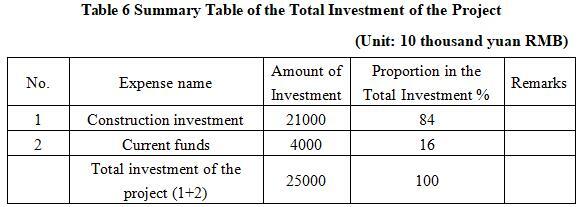
1.3.2 Capital raising
Raised by the enterprise itself.
1.4 Financial analysis and social evaluation
1.4.1 Main financial indexes
After the project reaches the production capacity, its annual sales revenue will be 130 million yuan, its profit will be 45 million yuan, its investment payback period will be 7.6 years (after the tax, including the construction period of 2 years) and its return on investment will be 18.0%.
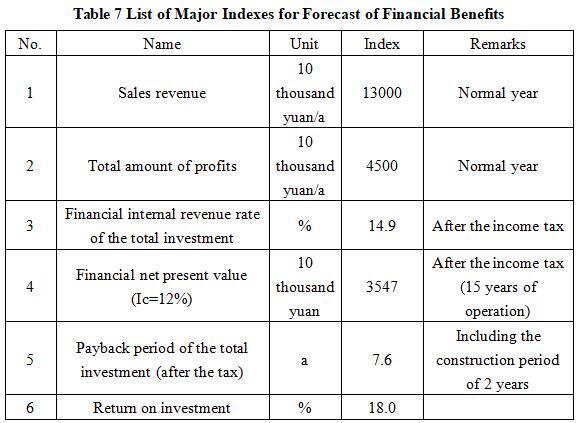
Note: “10 thousand yuan” in the table is in RMB
1.4.2 Social evaluation
The implementation of the project will promote the transformation and upgrading of the plastic industry, promote green and sustainable development. The use of biodegradable plastic bags produced by the project will effectively reduce environmental pollution and have a positive impact on environmental protection. The implementation of the project can also provide more employment opportunities, increase personnel employment, contribute to social stability, and have good social and economic benefits.
1.5 Cooperative way
Sole proprietorship, and cooperation.
1.6 What to be invested by the foreign party
Funds, equipment and technology.
1.7 Construction site of the project
Tongyu Economic Development Zone.
1.8 Progress of the project
The project proposal has been prepared.
2. Introduction to the Partner
2.1 Basic information
Name: Tongyu Economic Development Zone
Address: About 50 m Northeast of the Intersection of Fengdian Road and Xinfa Street in Tongyu County, Baicheng City
2.2 Overview
Tongyu County Economic Development Zone was established in July 2005 and was promoted to a provincial development zone in January 2012. The total area of the development zone is 34.41 million ㎡, divided into one main park and three outer parks. The main park covers an area of 21.94 million ㎡, the Tiexi Industrial Park covers an area of 7.3 million ㎡, the Yingxin Industrial Park covers an area of 3.46 million ㎡, and the Hujiadian Industrial Park covers an area of 1.71 million㎡. The built-up area accounts for 10.49 million ㎡, the area outside the built-up area accounts for 23.92 million㎡, and there is still a usable land area of 20.93 million ㎡. At present, there are a total of 50 enterprises and projects in the development zone, including 42 industrial enterprises, 12 enterprises above designated size (Sany, Huishang, Tianyi, Dadi Gas, Jiayi Technology, Wanjia Heating, Yonfer, Envision, Fuhao Cement, Qianyu Concrete, Yifahe, Tianneng), and 38 enterprises below designated size. The enterprises in the development zone are mainly in the secondary and tertiary industries, and the enterprises in the zone have driven employment of about 4,300 people.
In recent years, the Tongyu County Committee and Government have attached great importance to the construction of a business environment. Adhering to the business environment means productivity and competitiveness. We will implement a “guarantee system” for key projects, a “mother system” for approval services, and an “early warning system” for administrative law enforcement. We will provide the best environment, fastest time, and best service throughout the entire process of project work, from investment negotiations to implementation and production. In order to fully serve project construction, Tongyu County has established a project center, with the county mayor personally serving as the director of the project center, providing comprehensive and full process services for investment promotion projects, achieving “zero errand running” for enterprises. In 2018 and 2020, it stood out among 60 counties (cities, districts) in the province and was awarded the title of Model County for Business Environment Construction. It is also the only county in Baicheng City to receive this honor.
2.3 Contact method
2.3.1 Contact method of cooperator
Contact unit: Tongyu County Economic Development Zone
Contact: Xi Xuehui
Tel: +86-13596824167
2.3.2 Contact method of the city (prefecture) where the project is located
Contact Unit: Baicheng Municipal Bureau of Commerce
Contact Person: Xu Zengchun
Tel: +86-436-3203010
+86-13894682986
E-mail: bcjhj07@126.com


